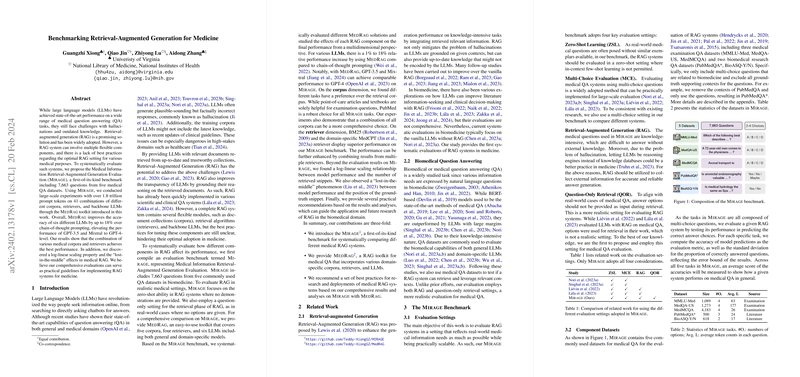Benchmarking Retrieval-Augmented Generation for Medical Question Answering
Introduction to Retrieval-Augmented Generation (RAG) in Medicine
Recent advancements in LLMs have significantly contributed to enhancing medical question answering (QA) systems. However, challenges such as the generation of inaccurate information ("hallucinations") and the use of outdated knowledge persist, raising concerns particularly in high-stakes fields like healthcare. Retrieval-Augmented Generation (RAG) has emerged as a promising approach to mitigate these issues by grounding LLM responses in relevant, retrieved documents from trustworthy sources. The flexibility inherent in RAG systems, due to their modular nature comprising of retrievers, corpora, and LLM backbones, mandates a comprehensive evaluation to delineate best practices for their implementation in medical contexts.
The Mirage Benchmark and MedRag Toolkit
To address this need for systematic evaluation, the Medical Information Retrieval-Augmented Generation Evaluation (Mirage) benchmark was introduced. Comprising 7,663 questions from five essential medical QA datasets, Mirage facilitates the examination of RAG systems' zero-shot capabilities across various medical question types. Alongside Mirage, a toolkit named MedRag was proposed, offering an accessible means to configure and test different combinations of RAG components, consisting of five distinct corpora, four retrieval algorithms, and six LLMs. This toolkit not only aids in the practical application of RAG systems in medicine but also in conducting large-scale, nuanced analyses to uncover correlations between system configurations and their performance on the benchmark.
Insights from the Evaluation
The evaluation of RAG systems using Mirage surfaced several key findings:
- A significant enhancement in LLM performance, by up to 18%, was observed when employing RAG over traditional chain-of-thought prompting. Remarkably, certain configurations enabled GPT-3.5 and Mixtral models to rival the performance of their more advanced counterpart, GPT-4.
- Preference for retrieval corpora varied with the task, highlighting the importance of corpus selection in RAG system configuration. The comprehensive MedCorp corpus, amalgamating multiple sources, emerged as a robust option across tasks, suggesting the value in cross-source retrieval.
- Among retrievers, domain-specific options like MedCPT showed superior performance in medical contexts. The implementation of fusion methods, such as Reciprocal Rank Fusion, further improved retrieval outcomes by aggregating results from multiple retrievers.
- The paper unveiled scaling properties indicating a log-linear relationship between model performance and the number of retrieved snippets. A "lost-in-the-middle" effect was identified, underscoring the nuanced impact of snippet positioning on answer accuracy.
Future Directions and Recommendations
The extensive analysis provided by the Mirage benchmark and MedRag toolkit lays the groundwork for future research and the refinement of medical RAG systems. Based on the results, several practical recommendations were proposed, including the selection of comprehensive corpora like MedCorp and the employment of domain-specific retrievers, especially in tasks where relevant literature is paramount.
Moreover, the observed performance scaling and snippet positioning effects invite further exploration into the optimization of retrieval depth and order. Additionally, the feasibility of incorporating newer RAG architectures and other potentially beneficial resources into MedRag presents promising avenues for enhancing the model's utility and reliability in medical QA.
Conclusion
In conclusion, the introduction of Mirage and MedRag represents a significant stride towards the optimization of RAG systems for medical question answering. Through systematic benchmarking, this work illuminates the pathways through which RAG configurations can be tailored to maximize accuracy and reliability in medical QA, marking an essential contribution to the field of computational healthcare.
